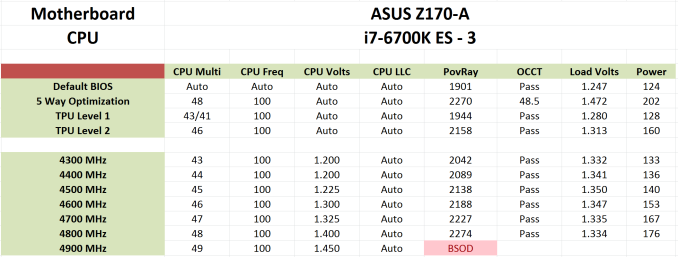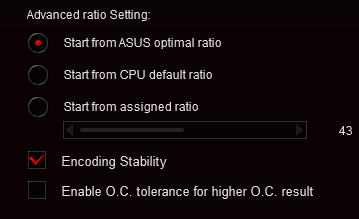The Intel Skylake i7-6700K Overclocking Performance Mini-Test to 4.8 GHz
by Ian Cutress on August 28, 2015 2:30 PM ESTFrequency Scaling
Below is an example of our results from overclock testing in a table that we publish in with both processor and motherboard. Our tests involve setting a multiplier and a frequency, some stress tests, and either raising the multiplier if successful or increasing the voltage at the point of failure/a blue screen. This methodology has worked well as a quick and dirty method to determine frequency, though lacks the subtly that seasoned overclockers might turn to in order to improve performance.
This was done on our ASUS Z170-A sample while it was being tested for review. When we applied ASUS's automatic overclock software tool, Auto-OC, it finalized an overclock at 4.8 GHz. This was higher than what we had seen with the same processor previously (even with the same cooler), so in true fashion I was skeptical as ASUS Auto-OC has been rather hopeful in the past. But it sailed through our standard stability tests easily, without reducing in overclocking once, meaning that it was not overheating by any means. As a result, I applied our short-form CPU tests in a recently developed automated script as an extra measure of stability.
These tests run in order of time taken, so last up was Handbrake converting a low quality film followed by a high quality 4K60 film. In low quality mode, all was golden. At 4K60, the system blue screened. I triple-checked with the same settings to confirm it wasn’t going through, and three blue screens makes a strike out. But therein is a funny thing – while this configuration was stable with our regular mixed-AVX test, the large-frame Handbrake conversion made it fall over.
So as part of this testing, from 4.2 GHz to 4.8 GHz, I ran our short-form CPU tests over and above the regular stability tests. These form the basis of the results in this mini-test. Lo and behold, it failed at 4.6 GHz as well in similar fashion – AVX in OCCT OK, but HandBrake large frame not so much. I looped back with ASUS about this, and they confirmed they had seen similar behavior specifically with HandBrake as well.
Users and CPU manufacturers tend to view stability in one of two ways. The basic way is as a pure binary yes/no. If the CPU ever fails in any circumstance, it is a no. When you buy a processor from Intel or AMD, that rated frequency is in the yes column (if it is cooled appropriately). This is why some processors seem to overclock like crazy from a low base frequency – because at that frequency, they are confirmed as working 100%. A number of users, particularly those who enjoy strangling a poor processor with Prime95 FFT torture tests for weeks on end, also take on this view. A pure binary yes/no is also hard for us to test in a time limited review cycle.
The other way of approaching stability is the sliding scale. At some point, the system is ‘stable enough’ for all intents and purposes. This is the situation we have here with Skylake – if you never go within 10 feet of HandBrake but enjoy gaming with a side of YouTube and/or streaming, or perhaps need to convert a few dozen images into a 3D model then the system is stable.
To that end, ASUS is implementing a new feature in its automatic overclocking tool. Along with the list of stress test and OC options, an additional checkbox for HandBrake style data paths has been added. This will mean that a system needs more voltage to cope, or will top out somewhere else. But the sliding scale has spoken.
Incidentally at IDF I spoke to Tom Vaughn, VP of MultiCoreWare (who develops the open source x265 HEVC video encoder and accompanying GUI interface). We discussed video transcoding, and I bought up this issue on Skylake. He stated that the issue was well known by MultiCoreWare for overclocked systems. Despite the prevalance of AVX testing software, x265 encoding with the right algorithms will push parts of the CPU beyond all others, and with large frames it can require large amounts of memory to be pushed around the caches at the same time, offering further permutations of stability. We also spoke about expanding our x265 tests, covering best case/worst case scenarios from a variety of file formats and sources, in an effort to pinpoint where stability can be a factor as well as overall performance. These might be integrated into future overclocking tests, so stay tuned.












103 Comments
View All Comments
MrSpadge - Thursday, September 3, 2015 - link
If HB exposes errors which the other programs do not find, it is a stress test. Just a different one. It's not about the highest power draw & temperature, but about a code path which apparently takes a bit longer to complete than others and hence can't be pushed to such high frequencies.Dr_Orgo - Sunday, August 30, 2015 - link
The conditionally stable overclocking results were pretty interesting. When I overclocked my GTX 970, I primarily used Unigine Heaven to stress test. Got to 1500 MHz stable with voltage maxed in Precision X. Used it in a number of games with zero crashing even with sustained 100% usage, seemed completely stable. Running the unit preloader (loads all units/annimations) in Starcraft 2 would make the game crash every time. Dropping the overclock to 1460 MHz made it stable. I'm not sure what specifically makes that unit preloader less overclock friendly.LemmingOverlord - Monday, August 31, 2015 - link
I think the premise behind the Discrete Graphics tests are incorrect. If you max out the settings you are capping the performance of the system by the graphics card. If you lower the settings just a bit, you'll definitely see how the CPU influences overall game performance. I know this is a mini-test, but these discrete tests prove absolutely nothing on how the overclock impacted the game performance.Either lower the detail on these tests, or test with a game that is non-GPU Intensive. Civ V is an excellent benchmark for CPU tests, because it really is CPU-intensive...
dimonakid - Sunday, September 6, 2015 - link
In the past couple of months, we see alot of BSOD and freez and what not from media encoding softwares.Some of our friends mentioned (while they were testing), that this maybea a global XMP issue.
Same resaults regarding handbrake were showing on z77 z68.
Just to comment
SeanJ76 - Monday, September 14, 2015 - link
Not impressed, my 4690k does 4.8ghz with a $29 Hyper Evo....InstinctXIV - Friday, November 20, 2015 - link
I would love to see your 4690K do this http://imgur.com/U6ZZ1Ll (It is my PC)gravy1958 - Monday, October 19, 2015 - link
I have a 6700k with an asus maximus ranger viii MB and an hours gaming produces regular clock_watchdog_timeout errors if I use the overclocking... and frequent boot fails with the random overclocking failed press F1 to enter setup 8^(gravy1958 - Monday, October 19, 2015 - link
should add it is set at 4.6Ghz and all advice points to the voltage being too low.jonainpdx - Thursday, May 5, 2016 - link
It's pretty obvious that overclocking a new, state of the art CPU is nothing more than a waste of money for a gamer.